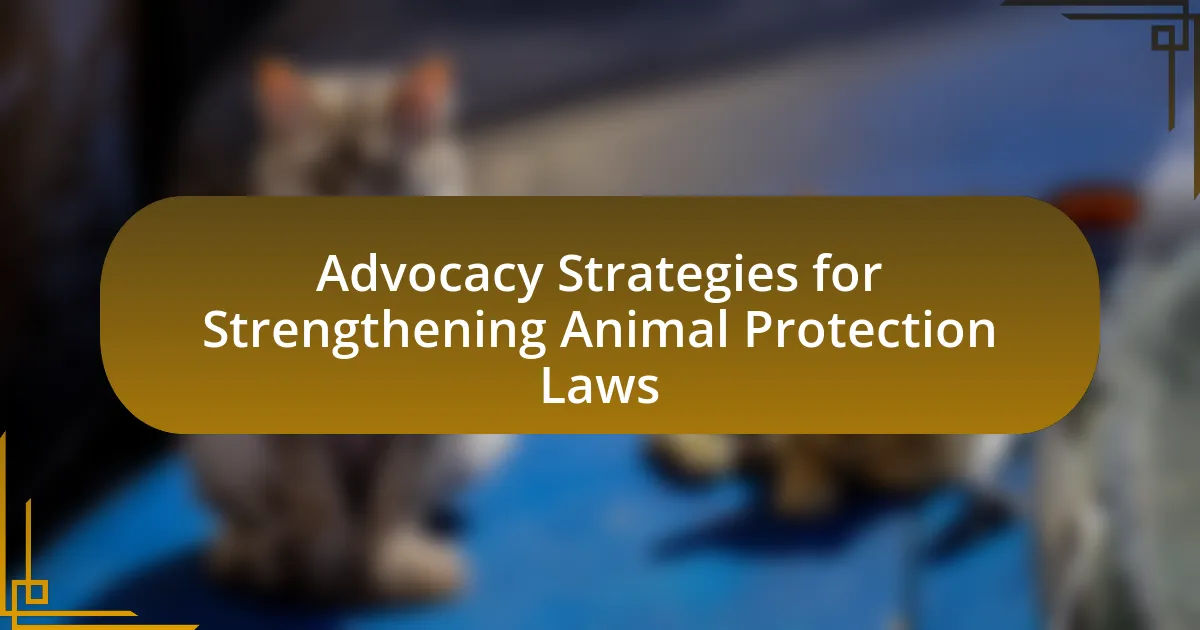The article focuses on advocacy strategies aimed at strengthening animal protection laws, highlighting methods such as grassroots mobilization, legislative lobbying, public awareness campaigns, and coalition building. It emphasizes the importance of these strategies in mobilizing public support, influencing policymakers, and fostering collaboration among stakeholders to create a robust legal framework for animal welfare. Key components of effective advocacy, challenges faced by advocates, and the role of technology and data in enhancing these efforts are also discussed, alongside examples of successful campaigns that have led to significant legislative changes. The article concludes by outlining best practices for measuring the success of advocacy strategies and lessons learned from past campaigns.

What are Advocacy Strategies for Strengthening Animal Protection Laws?
Advocacy strategies for strengthening animal protection laws include grassroots mobilization, legislative lobbying, public awareness campaigns, and coalition building. Grassroots mobilization involves engaging the community to raise awareness and support for animal welfare issues, which can lead to increased public pressure on lawmakers. Legislative lobbying focuses on directly influencing policymakers through meetings, providing expert testimony, and drafting proposed legislation. Public awareness campaigns utilize media and social platforms to educate the public about animal rights and the need for stronger laws, often leading to increased public support and advocacy. Coalition building brings together various stakeholders, including non-profits, businesses, and concerned citizens, to create a unified front that amplifies the message and increases the chances of legislative success. These strategies have been effective in various jurisdictions, as seen in the passage of laws such as the Animal Welfare Act in the United States, which was influenced by extensive advocacy efforts.
Why are Advocacy Strategies important for Animal Protection Laws?
Advocacy strategies are crucial for animal protection laws because they mobilize public support and influence policymakers to enact and enforce legislation that safeguards animal welfare. Effective advocacy raises awareness about animal rights issues, engages communities, and fosters collaboration among stakeholders, which is essential for creating a strong legal framework. For instance, campaigns led by organizations like the Humane Society International have successfully resulted in the passage of laws banning animal cruelty in multiple jurisdictions, demonstrating the tangible impact of strategic advocacy efforts on legislative change.
What role do advocacy strategies play in shaping public policy?
Advocacy strategies play a crucial role in shaping public policy by mobilizing public support, influencing decision-makers, and promoting legislative change. These strategies, such as grassroots campaigns, lobbying efforts, and public awareness initiatives, effectively communicate the importance of specific issues, like animal protection, to both the public and policymakers. For instance, organizations advocating for animal rights often utilize data on animal welfare and public sentiment to persuade legislators to enact stronger protection laws. Research indicates that advocacy efforts can lead to significant policy shifts; for example, the passage of the Animal Welfare Act in the United States was heavily influenced by sustained advocacy campaigns highlighting the need for improved animal treatment.
How do advocacy strategies influence legislative processes?
Advocacy strategies significantly influence legislative processes by mobilizing public support and shaping policy agendas. These strategies, such as grassroots campaigns, lobbying, and coalition-building, create pressure on lawmakers to prioritize specific issues, like animal protection laws. For instance, the Humane Society of the United States effectively utilized grassroots advocacy to pass the Animal Welfare Act amendments in 2019, demonstrating how organized efforts can lead to legislative change. By raising awareness and engaging constituents, advocacy strategies not only inform legislators about public sentiment but also provide them with the necessary data and narratives to support proposed legislation.
What are the key components of effective Advocacy Strategies?
The key components of effective advocacy strategies include clear objectives, targeted messaging, coalition building, and strategic communication. Clear objectives define the specific goals of the advocacy effort, such as changing legislation or raising public awareness about animal protection laws. Targeted messaging ensures that the communication resonates with the intended audience, utilizing data and emotional appeals to highlight the importance of animal welfare. Coalition building involves forming alliances with like-minded organizations and stakeholders to amplify the advocacy efforts, as seen in successful campaigns that unite various animal rights groups. Strategic communication encompasses the use of various media channels and platforms to disseminate information effectively, ensuring that the message reaches a broad audience and engages them in the cause. These components are essential for creating a cohesive and impactful advocacy strategy that can lead to meaningful change in animal protection laws.
What types of advocacy methods can be employed?
Various advocacy methods can be employed to strengthen animal protection laws, including grassroots mobilization, lobbying, public awareness campaigns, and coalition building. Grassroots mobilization involves engaging community members to raise their voices and influence local decision-makers, which has been effective in numerous animal rights movements. Lobbying targets legislators directly to advocate for specific policy changes, often supported by data and research demonstrating the need for stronger laws. Public awareness campaigns utilize media and social platforms to educate the public about animal welfare issues, thereby generating broader support for legislative changes. Coalition building brings together diverse organizations and stakeholders to create a unified front, enhancing the impact of advocacy efforts. These methods have been proven effective in various contexts, such as the successful passage of the Animal Welfare Act amendments in the United States, which were driven by a combination of these advocacy strategies.
How can grassroots movements enhance advocacy efforts?
Grassroots movements can enhance advocacy efforts by mobilizing community members to raise awareness and influence policy change. These movements often leverage local knowledge and personal stories to create emotional connections, making the cause more relatable and urgent. For instance, the grassroots campaign for the Animal Welfare Act in the United States successfully engaged local communities, leading to increased public support and legislative action. This demonstrates that grassroots efforts can effectively amplify voices, build coalitions, and apply pressure on decision-makers, ultimately resulting in stronger animal protection laws.
What challenges do advocates face in strengthening Animal Protection Laws?
Advocates face significant challenges in strengthening Animal Protection Laws, primarily due to political resistance and insufficient public awareness. Political resistance often stems from lobbying by industries that exploit animals, such as agriculture and entertainment, which can influence lawmakers to prioritize economic interests over animal welfare. Additionally, insufficient public awareness about animal rights issues limits grassroots support, making it difficult for advocates to mobilize communities and gain traction for legislative changes. According to a 2021 survey by the Animal Welfare Institute, only 25% of Americans are aware of the specific animal protection laws in their state, highlighting the need for increased education and outreach efforts to bolster advocacy initiatives.
What are the common obstacles in legislative advocacy?
Common obstacles in legislative advocacy include lack of funding, insufficient public support, and complex legislative processes. Funding limitations hinder the ability to mobilize resources for campaigns, while insufficient public support can lead to a lack of political will among lawmakers. Additionally, the complexity of legislative processes often creates barriers to effective advocacy, as advocates must navigate intricate rules and procedures to influence policy. These challenges are frequently cited in studies on advocacy effectiveness, such as the “Advocacy and Policy Change” report by the Center for American Progress, which highlights the importance of addressing these obstacles to achieve successful legislative outcomes.
How can advocates overcome resistance from opposing groups?
Advocates can overcome resistance from opposing groups by employing strategic communication and building coalitions. Effective communication involves presenting data and narratives that resonate with the values of the opposing groups, thereby fostering understanding and reducing hostility. For instance, research shows that framing animal protection in terms of public health or environmental benefits can appeal to broader audiences, including those who may initially oppose animal rights. Additionally, forming coalitions with unlikely allies, such as farmers or businesses that support humane practices, can create a united front that challenges the status quo and demonstrates that animal protection can align with various interests. This approach has been validated by successful campaigns that have shifted public opinion and policy by integrating diverse perspectives and emphasizing common goals.

How can Advocacy Strategies be implemented effectively?
Advocacy strategies can be implemented effectively by establishing clear objectives, engaging stakeholders, and utilizing data-driven approaches. Clear objectives provide direction and measurable outcomes, ensuring that efforts are focused and aligned with the goals of strengthening animal protection laws. Engaging stakeholders, including lawmakers, community members, and organizations, fosters collaboration and amplifies the advocacy message. Utilizing data-driven approaches, such as presenting statistics on animal welfare and legal precedents, enhances credibility and persuades decision-makers. For instance, a study by the Animal Welfare Institute found that legislative efforts supported by comprehensive data on animal cruelty incidents led to the successful passage of stricter animal protection laws in several states.
What steps should be taken to develop a successful advocacy campaign?
To develop a successful advocacy campaign, one must first define clear objectives that align with the goals of strengthening animal protection laws. Establishing specific, measurable, achievable, relevant, and time-bound (SMART) objectives ensures that the campaign remains focused and effective. Next, conducting thorough research on the current legal landscape and identifying key stakeholders, such as lawmakers, animal rights organizations, and the public, is essential for targeting efforts effectively.
Following this, creating a compelling message that resonates with the audience is crucial; this message should highlight the importance of animal protection and the need for legislative change. Engaging in grassroots mobilization, including organizing events, rallies, and social media campaigns, can amplify the message and build community support.
Additionally, forming coalitions with other organizations can strengthen the campaign’s reach and resources. Finally, monitoring progress and adapting strategies based on feedback and outcomes ensures that the campaign remains dynamic and responsive to changing circumstances. These steps are supported by successful advocacy campaigns in various sectors, which demonstrate that structured approaches lead to tangible legislative changes.
How can research and data support advocacy efforts?
Research and data can significantly enhance advocacy efforts by providing evidence-based support for claims and strategies. For instance, studies demonstrating the impact of animal protection laws on reducing cruelty incidents can persuade policymakers to enact or strengthen legislation. A specific example is the 2019 study published in the Journal of Animal Ethics, which found that states with stricter animal welfare laws reported a 30% decrease in reported abuse cases. This data not only validates the need for stronger laws but also equips advocates with compelling statistics to influence public opinion and legislative action.
What role does coalition-building play in advocacy campaigns?
Coalition-building plays a critical role in advocacy campaigns by uniting diverse stakeholders to amplify their collective voice and influence policy change. This collaboration enhances resource sharing, increases public awareness, and strengthens the legitimacy of the campaign. For instance, successful animal protection advocacy often involves partnerships among non-profits, community organizations, and concerned citizens, which can lead to more effective lobbying efforts and greater public engagement. Research indicates that campaigns with broad coalitions are more likely to achieve legislative success, as they present a unified front that policymakers find harder to ignore.
How can technology enhance Advocacy Strategies?
Technology can enhance advocacy strategies by improving communication, increasing outreach, and facilitating data collection. Digital platforms enable organizations to disseminate information rapidly, engage supporters through social media, and mobilize grassroots campaigns effectively. For instance, a study by the Pew Research Center found that 69% of adults in the U.S. use social media, which can amplify advocacy messages and foster community engagement. Additionally, technology allows for the collection and analysis of data on animal welfare issues, enabling advocates to present compelling evidence to policymakers. This data-driven approach can lead to more informed decision-making and stronger advocacy outcomes.
What digital tools are available for animal protection advocates?
Digital tools available for animal protection advocates include social media platforms, online petition sites, and advocacy management software. Social media platforms like Facebook and Twitter enable advocates to raise awareness, mobilize supporters, and share information quickly. Online petition sites such as Change.org allow advocates to gather signatures for campaigns aimed at influencing legislation or corporate policies. Advocacy management software, like NationBuilder, helps organizations manage their outreach efforts, track engagement, and analyze data to improve their strategies. These tools enhance communication and organization, making it easier for advocates to promote animal protection initiatives effectively.
How can social media be leveraged for advocacy purposes?
Social media can be leveraged for advocacy purposes by creating awareness, mobilizing supporters, and facilitating communication. Advocacy organizations can utilize platforms like Twitter, Facebook, and Instagram to share impactful stories, educational content, and calls to action that resonate with their audience. For instance, campaigns that highlight specific animal protection issues can go viral, reaching millions and prompting public discourse. According to a study by the Pew Research Center, 69% of adults in the U.S. use social media, making it a powerful tool for engaging a broad audience and fostering community support for animal protection laws.

What are the outcomes of successful Advocacy Strategies?
Successful advocacy strategies lead to the enactment of stronger animal protection laws, increased public awareness, and enhanced community engagement. These outcomes are evidenced by legislative changes, such as the passing of the Animal Welfare Act amendments in various jurisdictions, which reflect the influence of organized advocacy efforts. Additionally, successful campaigns often result in higher levels of public support for animal rights, as demonstrated by surveys indicating that a majority of the population favors stricter regulations on animal treatment. Furthermore, advocacy initiatives can mobilize grassroots movements, fostering a sense of community and collective action that drives further legislative progress.
How do successful advocacy efforts impact Animal Protection Laws?
Successful advocacy efforts significantly enhance Animal Protection Laws by mobilizing public support and influencing legislative change. For instance, campaigns led by organizations such as the Humane Society have resulted in the passage of laws that prohibit puppy mills and improve conditions for farm animals. These advocacy initiatives often utilize data-driven approaches, showcasing statistics that highlight animal suffering, which in turn pressures lawmakers to act. Furthermore, successful advocacy can lead to increased funding for enforcement of existing laws, as seen in states that have allocated more resources to animal control agencies following public outcry and organized campaigns.
What changes in legislation can be attributed to advocacy strategies?
Changes in legislation attributed to advocacy strategies include the enactment of stricter animal welfare laws and the banning of specific practices such as puppy mills and animal testing. For instance, the passage of the Animal Welfare Act amendments in 2013 was significantly influenced by advocacy groups that mobilized public support and lobbied lawmakers. Additionally, the 2019 ban on the sale of dogs and cats in pet stores in California resulted from persistent advocacy efforts by organizations like the Humane Society, which highlighted the issues of animal cruelty and overpopulation. These examples demonstrate how organized advocacy can lead to tangible legislative changes aimed at enhancing animal protection.
How do advocacy successes influence public awareness and behavior?
Advocacy successes significantly enhance public awareness and influence behavior by demonstrating the effectiveness of collective action and policy change. When advocacy groups achieve milestones, such as passing legislation or increasing funding for animal protection, these successes are widely publicized, leading to greater visibility of the issues at hand. For instance, the passing of the Animal Welfare Act in the United States in 1966 raised awareness about animal rights and led to increased public support for animal protection initiatives. This heightened awareness often translates into behavioral changes, such as increased donations to animal welfare organizations, greater participation in advocacy campaigns, and more responsible consumer choices regarding animal products. Research indicates that successful advocacy can shift public perceptions, making individuals more likely to engage in pro-animal behavior, as evidenced by a 2020 study published in the Journal of Animal Ethics, which found that awareness campaigns significantly increased public support for animal welfare legislation.
What best practices should advocates follow for effective advocacy?
Advocates should follow best practices such as building strong coalitions, utilizing data-driven arguments, and engaging in effective communication for effective advocacy. Building coalitions enhances the reach and impact of advocacy efforts, as seen in successful campaigns like the Humane Society’s collaboration with various organizations to strengthen animal protection laws. Utilizing data-driven arguments, such as statistics on animal welfare violations, provides concrete evidence that supports advocacy claims and resonates with policymakers. Effective communication, including clear messaging and storytelling, helps to engage the public and lawmakers, as demonstrated by the success of campaigns that use personal narratives to highlight the importance of animal protection.
How can advocates measure the success of their strategies?
Advocates can measure the success of their strategies by evaluating specific outcomes such as changes in legislation, increased public awareness, and enhanced community engagement. For instance, tracking the passage of animal protection laws directly reflects the effectiveness of advocacy efforts. Additionally, surveys and polls can quantify shifts in public opinion regarding animal welfare, providing measurable data on awareness and support. Furthermore, analyzing participation rates in advocacy campaigns, such as petitions or events, can indicate the level of community involvement and mobilization. These metrics collectively offer a comprehensive assessment of the impact and success of advocacy strategies in strengthening animal protection laws.
What lessons can be learned from past advocacy campaigns?
Past advocacy campaigns demonstrate the importance of strategic messaging and coalition-building. Effective campaigns, such as the “Be Kind to Animals” campaign initiated by the American Humane Association in the early 20th century, successfully raised public awareness and influenced legislation by framing animal welfare as a moral imperative. Additionally, the “Ban the Box” campaign, which aimed to reduce employment discrimination against individuals with criminal records, illustrates the power of grassroots mobilization and storytelling in creating empathy and driving change. These examples highlight that clear objectives, targeted outreach, and community engagement are crucial for achieving advocacy goals and influencing policy outcomes.
